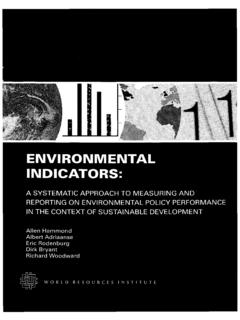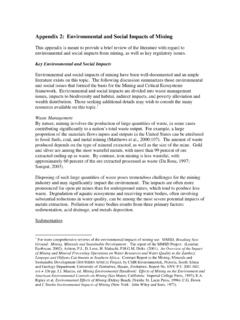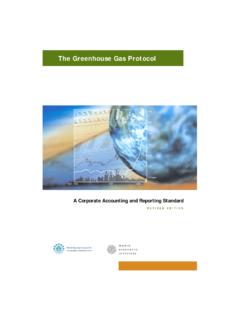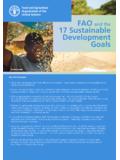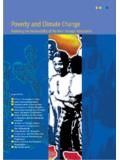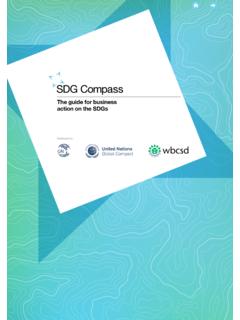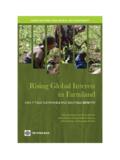Transcription of Analysis of the Effects of Microfinance on Poverty Reduction
1 Analysis of the Effects of Microfinance on Poverty Reduction Jonathan Morduch Robert F. Wagner Graduate School of Public Service New York University 4 Washington Square North New York, NY 10003. Barbara Haley RESULTS Canada NYU Wagner Working Paper No. 1014. Issued June 28, 2002. The NYU Wagner Working Paper Series is intended to disseminate work in preliminary form to encourage discussion and comment. This and other papers may be downloaded at The views expressed herein are those of the author(s) and not necessarily those of NYU Wagner. 2002 by Jonathan Morduch and Barbara Haley. All rights reserved. Short sections of text, not to exceed two paragraphs, may be quoted without explicit permission provided that full credit is given to the source.
2 Analysis of the Effects of Microfinance on Poverty Reduction Prepared by Jonathan Morduch and Barbara Haley RESULTS Canada for the Canadian International Development Agency November 2001. Acknowledgements This report was completed thanks to the expertise, dedication and effort of the following individuals: Narima Amin Bill Campbell Deb Ireland Calvin Kangara Ash Khan Pamela Walden Landry Catherine Little Anita Mark Oliver Mark Randy Rudolph Blaise Salmon Lana Skulmoski Stephen St. Denis Jean-Francois Tardif Laurier Trahan ii Table of Contents Page Acknowledgements ii Overview 1. Effects of Microfinance on Poverty Reduction as Defined by the Millennium Goals Section 1: Introduction 6.
3 Evidence for a Reduction in Poverty 7. Concerns 27. Degree of Poverty 37. Secondary Sources: Section 1 56. Section 2: Introduction 64. Savings-First vs. Credit-First 65. Secondary Sources: Section 2 83. Microfinance and Other Development Tools: Comparative Effects of Poverty Reduction Section 3: Introduction 84. Should there be a combination of Microfinance and other development tools to 85. enhance synergies? Increased effectiveness 85. Examples of synergistic combinations 86. UNICEF 86. Comparative strengths and weaknesses of Microfinance vs. other development tools 92. Strengths 92. Cost effectiveness 92. Powerful leveraging effect 93. Potentially financially sustainable 93.
4 Weaknesses 95. Less universal in its application 95. Borrowers need to be suitably entrepreneurial 96. Credit as debt and loan usage 96. Limited growth potential 97. Rating Microfinance against other development tools and interventions in terms of 98. reducing Poverty Rigorous analyses lacking 99. Microfinance and other Social Welfare Programs 99. Microfinance and Basic Education 101. Microfinance and Basic Health Care 104. Microfinance and Family Planning 107. Microfinance and Nutrition 108. Microfinance and Economic Programming 109. Microfinance and Water/Sanitation 113. Microfinance and HIV/AIDS 113. Microfinance and Shelter 115. Secondary Sources: Section 3 116.
5 Iii Table of Contents (continued). Section 4: Introduction 119. Reduced Risks and Increased Positive Impacts 120. Secondary Sources: Section 4 144. References 145. Appendix A Terms of Reference 154. Appendix B Defining Poverty 155. iv Overview Analysis of the Effects of Microfinance on Poverty Reduction : Overview The poorest and Poverty Reduction have become the object of unprecedented attention at international summits in the 1990's. Canada, through the Canadian International Development Agency (CIDA), has committed to the targets set by both the OECD International Development Goals and, most recently, the Millennium Goals which focus on Poverty Reduction for those living on less than a dollar a day.
6 Microfinance has proven to be an effective and powerful tool for Poverty Reduction . Like many other development tools, however, it has insufficiently penetrated the poorer strata of society. The poorest form the vast majority of those without access to primary health care and basic education; similarly, they are the majority of those without access to Microfinance . While there is no question that the poorest can benefit from primary health care and from basic education, it is not as intuitive that they can also benefit from Microfinance , or that Microfinance is an appropriate tool by which to reach the Millennium goals. Microfinance has been extensively examined over the past 10 to 15 years, and the resulting literature is now very large.
7 A focused review of the literature was conducted to evaluate recent publications regarding the impact of Microfinance on Poverty Reduction . 1. The number of rigorous studies of client outreach and impact has grown considerably, especially in the past few years, spurred in part by the development of monitoring tools like CGAP's Poverty Assessment Tool, Cashpor Housing index, SEF's Participatory Wealth Ranking, and USAID's AIMS Tools. The resulting studies show that: The tools are relatively inexpensive and practical to use, and they yield useful data for both programs and donors. Average loan size is an easy indicator to collect but proves to be unreliable when measuring depth of outreach.
8 Minimal extra effort in data collection can yield much richer information for marketing and evaluation. Microfinance institutions (MFIs) show considerable diversity in their ability to reach poor populations. Excellent financial performance does not imply excellence in outreach to poor households. At the same time, reaching the poor is not at odds with maintaining excellent financial performance and professional business practices. Programs that make Poverty Reduction an explicit goal and make it a part of their organizational culture are far more effective at reaching poor households than those that value finance above all else. These lessons point to natural evolutions in the Microfinance sector.
9 Many MFIs have tended to focus foremost on their own financial survival, and have generally been reluctant to invest substantially in evaluations (World Bank 1998). Currently, the majority of MFIs neither determines the composition of their clientele upon intake nor evaluates the effectiveness of their program in terms of Poverty Reduction . The development and use of the new tools for market Analysis and evaluation suggests that failure to monitor 1. See Appendix A for a list of the questions and terms of reference. Sources include the Consultative Group to Assist the Poorest (CGAP), Eldis index, USAID (AIMS project), ILO Social Finance Unit, UN Capital Development Fund (UNCDF), and the World Bank's Sustainable Banking with the Poor project.
10 1. Overview and evaluate can cut costs in the short-run at the expense of achieving long-term social and economic goals. Social and economic impacts The review of the literature also points to several specific conclusions about the impact of Microfinance on Poverty Reduction : Evidence shows the positive impact of Microfinance on Poverty Reduction as it relates to the first six out of seven Millennium While the quality of many studies could be improved 3, there is an overwhelming amount of evidence substantiating a beneficial affect on: o Increases in income (Wright 2000; UNICEF 1997; Khandker 2001, 1998). o Reductions in vulnerability (Wright 2000, Zaman 2000; McCulloch and Baulch 2000).

